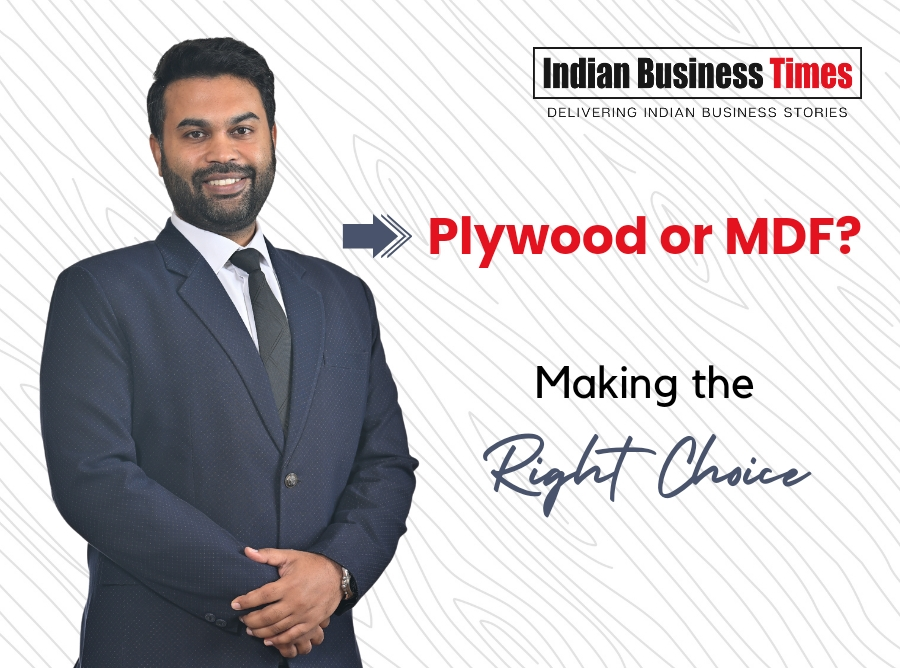In an enlightening conversation with Shrey Mittal of Sri Sri Plywoods, Ambala, we explore the essential considerations between Plywood or MDF, providing expert insights to help you determine which is better for your projects.

In navigating the complexities of construction and interior design, the choice between “Plywood or MDF” stands as a critical decision for professionals and homeowners alike. To demystify this choice and address the widespread queries related to the use, advantages, and considerations of Plywood or MDF, we turned to an expert in the field, Shrey Mittal, Founder of Sri Sri Plywoods, Ambala. Bringing a wealth of experience and a nuanced understanding of these materials, Mr. Mittal engaged with us in a detailed conversation aimed at clarifying the distinctions and benefits of each. This article encapsulates our discussion with Mr. Mittal, offering readers a deep dive into the comparative analysis of Plywood or MDF. Whether your priorities lie in durability, affordability, environmental sustainability, or overall quality, this dialogue with Mr. Mittal is designed to equip you with the knowledge needed to make an informed decision between Plywood or MDF for your next project.
1. Mr. Mittal, could you please share with us your journey in the plywood industry and how you established Sri Sri Plywoods in Ambala?
My journey in the plywood industry began 12 years ago, post my engineering degree from Bharatiya Vidyapeeth, Pune. After a brief stint in a job, I ventured into the family business, initially established by my father as a wholesaler in Lalru, near Ambala. In 2015, I took a significant leap by starting my own venture, Sri Sri Plywoods, in Ambala, offering both retail and wholesale services. Starting with a modest team comprising a salesman and two laborers, I managed the operations single-handedly, focusing on understanding and fulfilling customer needs.
This hands-on approach and direct customer interaction have been key to my success, allowing me to personally attend to over 50,000 customers and sell more than a crore plywood sheets. My engineering background and keen insight into customer requirements have enabled me to offer tailored solutions, ensuring the steady growth of Sri Sri Plywoods. Through dedication and a deep understanding of the market, I have navigated my venture from its humble beginnings to a significant presence in the industry.
2. For our readers who may not be familiar, could you explain the basic differences between plywood or MDF in terms of material composition and manufacturing process?
Plywood is crafted through a meticulous process where tree logs are peeled into thin layers, akin to sharpening a pencil, creating multiple veneers. These veneers are then layered, usually perpendicularly, and bonded under high pressure and heat to form plywood. This method gives plywood its unique strength and durability, allowing it to withstand heavy loads and resist warping.
On the other hand, MDF (Medium Density Fibreboard) is made from wood fibers that are ground finely, mixed with resins, and formed under high pressure and temperature into panels. MDF comes in various densities, such as HDF (High Density Fibreboard) and HDHMR (High Density High Moisture Resistant), catering to different requirements. While MDF panels present a homogeneous appearance without visible layers, making them ideal for smooth finishes, they differ from plywood in terms of screw holding capacity and resistance to moisture.
The primary distinction lies in their manufacturing process and material composition, leading to differences in physical properties. Plywood, known for its layered structure, offers excellent strength and flexibility. MDF, characterized by its uniform density, provides a smooth surface for painting and cutting but is generally less resistant to moisture and has a lower screw holding capacity compared to plywood.
3. In your experience, what are the primary factors that determine whether plywood or MDF is more suitable for a specific project, such as a home, office, or restaurant?
Choosing between plywood and various types of fiberboards like MDF (Medium Density Fiberboard), HDF (High Density Fiberboard), and HDHMR (High Density High Moisture Resistant) for specific projects depends on several factors, including material properties, cost, and application area.
MDF, known for its lower density and screw holding capacity, is not water-resistant and tends to swell when exposed to moisture. This makes it less suitable for areas prone to water exposure. HDF offers a slightly higher density and better water resistance than MDF, making it a better choice for areas with minimal moisture exposure. However, HDHMR stands out with its superior density, screw holding capacity, and water resistance, making it ideal for home furniture where durability and longevity are paramount. Despite being the most expensive, HDHMR’s attributes justify its use in high-quality furniture.
In terms of application, for home environments, HDHMR is recommended for furniture due to its high performance, whereas plywood is preferred for structural elements like beds and doors because of its strength and lighter weight, which is easier on hinges. In kitchens, both plywood and HDHMR are viable, depending on the specific requirements and exposure to water.
It’s crucial to note that despite the claims, MDF, HDF, and HDHMR are not waterproof or termite proof but are resistant to some extent. This distinction is important for setting realistic expectations regarding their performance.
For office furniture, the choice between HDHMR and plywood can be based on specific needs, including screw retention and durability under load. Plywood offers better re-screwing capabilities and can support more weight compared to HDHMR, which might expand more when exposed to water.
An environmental consideration is the dust produced during cutting. Plywood’s heavier particles settle quickly, minimizing inhalation risks, whereas HDHMR’s finer particles can remain airborne longer, posing respiratory risks to carpenters.
In summary, the choice between these materials should be informed by their physical properties, cost, intended use, and environmental impact, ensuring the selected material aligns with the project’s durability, aesthetic, and health requirements.
Also read: Ecobillz Founder Ameet Patil – Shaping Sustainability with AI-Powered Efficiency.
4. How do the durability and longevity of plywood compare to MDF in various applications, like furniture, flooring, or cabinetry?
Plywood stands out for its durability and longevity, earning a perfect score from me based on its evolution and improved resistance to termites and water damage over the years. Reflecting on the plywood used in my old home built in 1984, which has remained intact against termite and moisture damage for 40 years, underscores its reliability. While MDF, HDF, and HDHMR offer promising features, they are newer to the market, and their long-term resilience, particularly against termites, is still under observation. Given the proven track record of plywood in various applications, I rate it highly for ensuring durability and longevity in construction and furniture.
5. What is the environmental impact of producing and using plywood versus MDF? Are there any sustainable practices in place at Sri Sri Plywoods to mitigate this impact?
The environmental impact of the plywood industry is often misunderstood, with many assuming it significantly harms the environment. However, this industry can actually be eco-friendly and economically beneficial. Sustainable practices involve farmers cultivating trees specifically for plywood production, harvesting them after 4-5 years, and then replanting, creating a cycle that benefits the environment and provides livelihoods. This approach, akin to farming, ensures continuous reforestation and is vastly different from harmful practices like indiscriminate jungle clearing for plywood production.
At Sri Sri Plywoods, we also address the health impact of material processing. Unlike MDF and HDHMR, which produce fine particles that can be hazardous to workers’ health, plywood manufacturing results in heavier particles that settle more quickly, minimizing respiratory risks. This commitment to environmental and health considerations reflects our dedication to sustainable and responsible business practices.
6. Could you discuss the cost differences between plywood and MDF? What advice would you give to someone trying to balance quality and budget?
When balancing quality and budget in choosing between plywood and MDF or HDHMR, it’s essential to understand the trade-offs involved. Quality-wise, plywood stands out due to its superior screw holding capacity, water resistance, and density. It doesn’t easily crack under pressure, making it a durable choice for long-term use. Therefore, for projects where quality and longevity are paramount, plywood is the recommended option.
However, from a budget perspective, MDF and HDHMR present more cost-effective solutions. A notable mention is the double side laminated MDF, which comes with a lamination (similar to sunmica) on both sides. This feature not only saves on the additional costs of lamination and adhesive (like fevicol) but also on time. For example, a piece of plywood priced at Rs. 50 could end up costing around Rs. 80/90 after including the expenses for double-side lamination. In contrast, MDF with pre-applied two-side lamination could be priced at Rs. 70, offering a more budget-friendly alternative.
In summary, if quality and durability are your top priorities, plywood is the way to go. However, if you are looking to manage costs while still achieving a satisfactory level of quality, MDF or HDHMR could be the better choice. The decision ultimately depends on the specific requirements of your project and your priorities between quality and budget.
Stay Tuned for More Insights
While this article currently explores six key questions about choosing between Plywood or MDF, our conversation with Shrey Mittal of Sri Sri Plywoods, Ambala, doesn’t end here. We have delved into more aspects of these essential building materials, and we’ll be updating this article shortly with further insights and expert advice. Keep an eye on this space to expand your understanding and ensure you make the most informed decision for your projects. Thank you for reading, and we look forward to bringing you more valuable information soon.
For expert advice regarding Plywood or MDF
Contact:
Shrey Mittal
Sri Sri Plywoods, Ambala
+91-98963 90374









